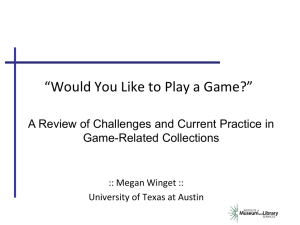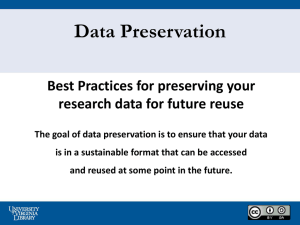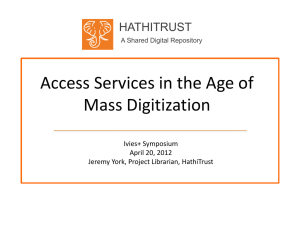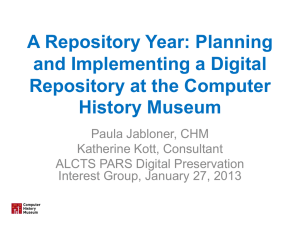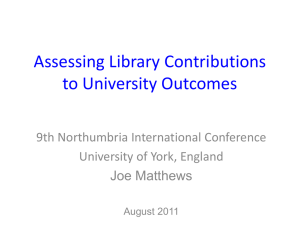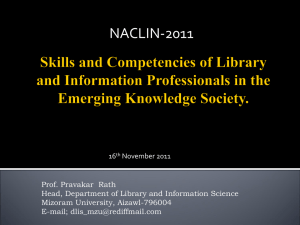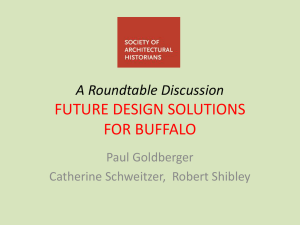What to Withdraw - Association of Southeastern Research Libraries
advertisement
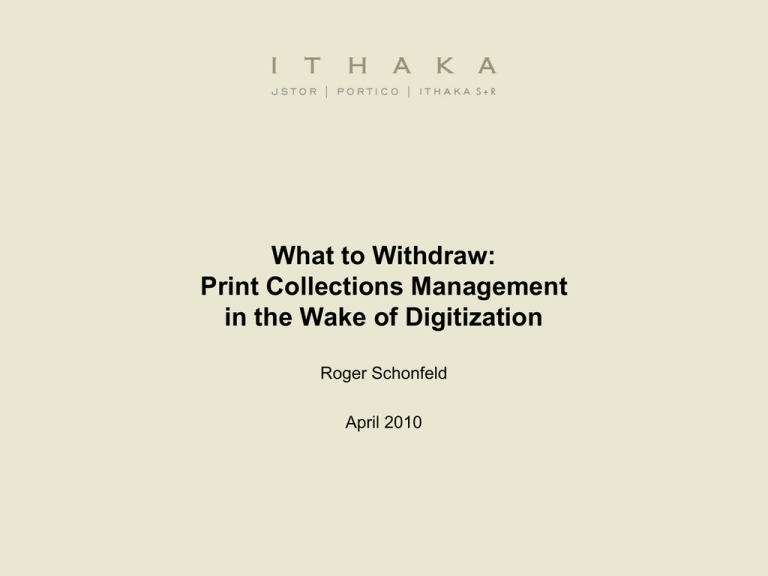
What to Withdraw: Print Collections Management in the Wake of Digitization Roger Schonfeld April 2010 Our Mission ITHAKA is a not-for-profit organization dedicated to helping the academic community take full advantage of rapidly advancing information and networking technologies. We serve scholars, researchers, and students by providing the content, tools, and services needed to preserve the scholarly record and to advance research and teaching in sustainable ways. We are committed to working in collaboration with other organizations to maximize benefits to our stakeholders. Our Services • Ithaka S+R works with initiatives and organizations to develop sustainable business models and conducts research and analysis on the impact of digital media on the academic community as a whole. • JSTOR helps scholars, researchers, and students discover, use, and build upon a wide range of content in a trusted digital archive of over 1,000 academic journals and other content. JSTOR uses information technology and tools to increase productivity and facilitate new forms of scholarship. • Portico preserves scholarly literature published in electronic form—more than 10,000 e-journals and 28,000 e-books—and ensures that these materials remains accessible to future scholars, researchers, and students. Organizational Commitment to Preservation • JSTOR – actively preserving over one thousand academic journals in both digital and print formats • Portico – digital preservation service providing a permanent archive of electronic journals, books, and other scholarly content • Ithaka S+R – Extensive work focusing on print collections management during a format transition – In addition to our work focused on scholarly journals, we have recently completed a project on government documents – Emphasis on developing policy framework to help libraries negotiate a format transition without sacrificing preservation Ithaka S+R Faculty Survey 2009: Journal Current Issues Support for cancelling print versions grows further Strong agreement with statement: “If my library cancelled the current issues of a print version of a journal but continued to make them available electronically, that would be fine with me.” 100% 90% 80% 70% 60% 50% 40% 30% 20% 10% 0% 2003 2006 2009 With all disciplinary groups favoring the transition Extent to which respondents agree with the statement: “If my library cancelled the current issues of a print version of a journal but continued to make them available electronically, that would be fine with me.” 100% 90% 80% 70% 60% 50% Not Well 40% Somewhat 30% Very Well 20% 10% 0% Humanities Social Sciences Sciences But winding down print publishing may be more challenging Strong agreement with statement: “I am completely comfortable with journals I use regularly ceasing print versions and publishing in electronic-only form” 100% 90% 80% 70% 60% 50% 40% 30% 20% 10% 0% Humanities Social Sciences Sciences Journal current issues • Broad acceptance, even among most humanities fields, of the cancellation of print in favor of electronic journal acquisitions • Some reservations about ceasing print publication altogether: – Preservation? – Reputation? • Publishers and libraries alike are eager to identify responsible strategies to wind down print publishing Ithaka S+R Faculty Survey 2009: Journal Backfiles Support for discarding print backfiles nearly doubles Strong agreement with the statement: “Assuming that electronic collections of journals are proven to work well and are readily accessible, I would be happy to see hard-copy collections discarded and replaced entirely by electronic collections.” 100% 90% 80% 70% 60% 50% 40% 30% 20% 10% 0% 2003 2006 2009 With key disciplinary differences among faculty Strong agreement with the statement: “Assuming that electronic collections of journals are proven to work well and are readily accessible, I would be happy to see hard-copy collections discarded and replaced entirely by electronic collections.” 100% 90% 80% 70% 60% 50% 40% 30% 20% 10% 0% Humanities Social Sciences 2003 2006 2009 Sciences Decreasing need to retain print, local and remote Strong agreement with the statements: “Regardless of how reliable and safe electronic collections of journals are, it will always be crucial for _______ to maintain hard-copy collections of journals.” 100% 90% 80% 70% 60% 50% 40% 30% 20% 10% 0% 2003 My college or university library 2006 Some college or university library 2009 Support for print collections may continue to erode Strong agreement with the statement: “Regardless of how reliable and safe electronic collections of journals are, it will always be crucial for _______ to maintain hard-copy collections of journals.” 100% 90% 80% 70% 60% 50% 40% 30% 20% 10% 0% 2003 2006 My college or university library 2009 2012 Some college or university library 2015 The overall context • Faculty are becoming increasingly prepared for and indeed “happy” about the format transition for academic journal backfiles • As print collections are digitized, many libraries face growing pressure to reduce the size of their corresponding print collections – and opportunities to redirect resources to new priorities • But it may be important to keep at least some print copies on behalf of the library community, even if not locally • Efficient choices that will ensure essential preservation and be sustainable well into the future are needed, both at individual libraries and across the library community What to Withdraw: The Dilemma of Print Preservation Balancing preservation and efficiency • Our fundamental question: If libraries will need to withdraw significant amounts of print, how can they prioritize “What to Withdraw” to reduce risk to the system? • Can a print repository strategy bring more efficiency to the system without sacrificing preservation interests? • Where are there risks? And can we reduce them? The approach 1. Identify community preservation needs, ie, How many copies need to be retained at minimum across the library community? 2. Disclose community preservation activities, ie, How many copies are being securely retained across the library community? 3. Analyze what can be withdrawn without preservation risk, ie, “Can my library confidently withdraw our copy?” 4. For other materials, determine how many more copies need to be preserved in order to provide libraries with that confidence. NOTE: We are not advising any individual library that it should, or should not, retain or withdraw, any of its holdings What to Withdraw Framework What to Withdraw: Print Collections Management in the Wake of Digitization (September 2009) http://www.ithaka.org/ithaka-s-r/research/what-to-withdraw What to Withdraw Framework: Overview • Define rationales for print preservation in the presence of digitized surrogate • Based on these rationales, categorize journals according to their relative preservation needs • Use an operations research methodology to determine the levels of print preservation required for each category What to Withdraw: Rationales for Print Preservation Rationales that are relevant for the whole community • Fix scanning errors • Inadequate scanning standards & practices • Inadequate digital preservation • Unreliable access • Scholarly needs • Campus politics Additional rationales that apply at the local level What to Withdraw: Examples of Categories Ideal Scenario Inadequate Digital Preservation Image Intensive Inadequate Digitization High digitization quality standards? Yes Yes Yes No Active errorcorrection? Yes Yes Yes Yes Reliable digital preservation? Yes No Yes Yes Image intensive? No No Yes No Reliable terms? Yes Yes Yes Yes n/a 100 years; and may not be a candidate for withdrawal at research libraries Minimum time horizon for retention of some copies system-wide 20 years; and a candidate for local withdrawal n/a What to Withdraw: Model • • Ithaka S+R commissioned Candace Yano, operations researcher at UC Berkeley, to develop a model for how many copies are needed to meet these preservation goals Assumption that dark archives have an annual “loss rate” of 0.1% What to Withdraw: Model • • Ithaka S+R commissioned Candace Yano, operations researcher at UC Berkeley, to develop a model for how many copies are needed to meet these preservation goals Assumption that dark archives have an annual “loss rate” of 0.1% Scenario Time Horizon Probability of Success Number of “Perfect,” Uncirculating Copies Required Ideal Scenario 20 >99% 2 What to Withdraw: Decision-Support Tool – Proof of Concept Regular webinars being held to present the framework and tool and answer questions. Check here for upcoming sessions: http://www.ithaka.org/ithaka-s-r/research/what-to-withdraw/print-collections-decision-support-tool What to Withdraw: First step • JSTOR-digitized titles offer an easy opportunity to apply this model in the short term: – Widely agreed to be of high quality and reliability – Two page-validated dim to dark archives (at Harvard and UC) – Widely held at libraries – Easy access to relevant data – Approximately 9,000 linear feet of holdings • We have developed a tool to provide libraries with information about preservation status of JSTOR-digitized titles by identifying titles which: – Have relatively few images – Are relatively completely held in both Harvard and UC archives “Actionable” Titles Count Titles Listing How This Tool Should Be Used (And How It Should Not) • A library can use this tool to identify a set of titles that are, according to criteria it sets itself, well-preserved elsewhere. • Copies of these titles held locally are therefore not needed for community preservation objectives, although there may be other reasons for retaining them. • The title list is not a picklist for a withdrawal project; any library may appropriately choose to locally maintain any or all of the items this tool identified because of other needs or priorities. • This list provides one source of information to guide a decisionmaking process; it cannot substitute for that process. What to Withdraw: Next Steps and Broader Considerations Current status • The What to Withdraw framework was released in the fall • ASERL publicly endorsed it in December • The decision-support tool was released in mid January • Ithaka S+R staff have conducted presentations and webinars on the framework and tool with more on the way • Numerous libraries have downloaded the decision-support tool and are beginning to make use of it in their decision-making • CRL is launching a major national program on print archives, led by Lizanne Payne Holdings disclosure, collections analysis, and decision support • Many libraries and library groups have expressed an interest in expanding the tool to incorporate many more journal titles – Consortia have expressed an interest in planning more systematically for shared collections, guaranteed access, and associated retention / withdrawal decisions. – Print repositories have expressed an interest in determining which materials need to be accessioned and which may be adequately preserved elsewhere already. – And individual libraries want to be able to make retain / withdraw decisions based on an awareness of materials’ preservation status. • This means not only more data in the existing tool, but building a more fully-featured tool that speaks to a broader set of individual library and collaborative needs Partnership of CRL and Ithaka S+R? • A potential CRL-Ithaka S+R partnership is being defined, within the context of our organizations’ broader print collection management / preservation projects and initiatives. • The purpose of this collaboration would be to develop decision support tools to support print archiving. • One key rationale for this partnership is to ensure that the tools developed are of the community, for the community, to ensure that whatever we develop has a truly system-wide effect A potential CRL-Ithaka S+R collaboration Procedures and systems to •identify and disclose archived holdings, •analyze collections, •facilitate collection management decisions, and •support access/delivery CRL: 1. Model service agreements 2. A business model and costsharing principles to facilitate network-level cooperation Ithaka S+R: 1. Intellectual framework 2. Advisory and implementation support services to libraries Some next steps • Refine the What to Withdraw framework to: – support volume validation, so more print repositories can participate – incorporate more quality paradigms beyond the “ideal scenario” • Incorporate more data into the tool: – holdings and condition data from additional print repositories – digitization and digital preservation information of many more titles • Redesign the tool to: – support consortial and print repository management needs – interact more readily with local systems • Offer advisory and implementation support services to libraries, consortia, and repositories Benefits and considerations • Coverage expanded to the 8,000-10,000 already-digitized titles, or more than10 linear miles of shelving, including many STEM journals • Libraries achieve significant space-saving opportunities • Preservation of these materials would be assured • Print repositories could be develop with greater efficiency and effectiveness – rather than today’s “lumpiness” • Build on existing models driven by local / regional incentives and relationships Discussion • Does further work on the intellectual framework and associated holdings/decision-support tools have value to you? If so what are your immediate and long-term priorities? – Digitized materials or all journal backfiles? – Journals alone or monographs as well? • Does a CRL – Ithaka S+R collaboration add value beyond efforts we might each pursue independently? • How if at all would you see ASERL and its members participating in such a national effort? • Does your institution need additional information, analysis, or support to make this national initiative more relevant or actionable? – Locally customized cost savings analyses? – Outside help to develop a long-term library collections management strategy? What to Withdraw: Print Collections Management in the Wake of Digitization Roger Schonfeld rcs@ithaka.org

